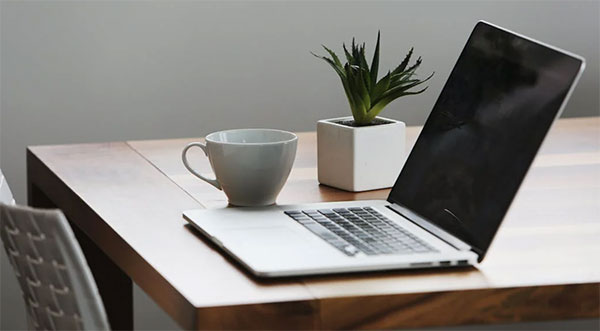Whether you’re working or playing, laptops are sleek, convenient computing machines. But what are the components that go into making one? We’re about to tell you everything you need to know.
A laptop has several primary components. The primary external components are the top panel, display, base panel, keyboard, touchpad, and palm rest assembly.
The main internal parts are the processor, RAM, hard drive, optical drive, video card, wireless card, fan, and battery. Combined, they create a functional computer.

External Laptop Parts
Laptop parts fall into two broad categories: external and internal. Let’s start by talking about the external parts – broadly speaking, the ones you can see.
Top Panel
The top panel is exactly what it sounds like – it’s the panel on top of your laptop. This is a flat surface, and is attached to the base with a hinge. It typically only opens one way. But some laptops have a rotating hinge that can be used to convert the laptop into a tablet.
The most important feature of the top panel is its size. A larger laptop can accommodate a bigger screen and keyboard. But it will also be a pain to haul around. A smaller laptop is more portable, but the keyboard may feel cramped and the screen may be too small.
Display (Screen)
The display is the laptop screen, and it’s attached to the inside of the top panel. Screens come in different sizes and resolutions, with different refresh rates and color quality. There may or may not be a touchscreen, depending on your laptop model.
Most modern laptops will also have a webcam above the display, but that’s not always the case.
Base Panel
The base panel is the bottom part of the laptop. It’s actually pretty important, because it holds all of the internal components. The CPU, hard drive, and other internal components all sit down in the base. For this reason, a base needs to be very sturdy and rigid.
Most laptops will come with small rubber skids on the bottom. These are designed to keep the laptop from scratching your desk.
Keyboard
The keyboard is exactly what it sounds like. It’s one of the two primary ways you interface with the computer. You use it to write emails, enter your password, and activate shortcut keys. Laptop keyboards have a tenkeyless design due to size constraints.
However, some have a ten key keypad built into the main keyboard that you can use with a function key. Many laptops also come with built-in LED backlighting. This lighting isn’t just attractive. It can also make it easier to identify which key is which if you’re not a touch typer.
Touchpad
The touchpad, sometimes called a trackpad, is the other primary interface. While you use the keyboard for typing, you use the touchpad for controlling the mouse. You slide your finger to move the mouse, and tap the pad or a button to click it.
Some laptops have a second button for right clicking. Others require you to tap with two fingers simultaneously in order to right click. You may also find a small nub in the middle of the keyboard. This is an alternate method of moving the mouse.
Palm Rest
The palm rest assembly is located on top of the base panel. It’s essentially a wide frame that surrounds the keyboard and touchpad. The surfaces to the sides of the touchpad act as an area where you can rest your palms when you’re typing.
This area also needs to be solid, because it protects the internal components. A good quality palm rest assembly will prevent dust or water egress into the laptop housing.

Internal Laptop Parts
Everything we’ve been discussing so far has been about the physical design of the laptop. But other than a couple of features, there’s really not much to discuss. When you’re choosing one laptop versus another one, you’re probably more concerned about what’s going on under the hood. Let’s talk about the various components you’ll find inside of your laptop.
Processor (CPU)
The processor, technically called the “central processing unit” or CPU, is the part of your computer that does the “thinking.” Anything you want to do with your laptop – anything at all – will require the use of the processor.
That said, some tasks are more CPU-intensive than others. For example, encoding video files can require a lot of processing power. Browsing the web, by comparison, uses very little processing power.
Hard Drive
The hard drive is where all of your data is stored. Photos, games, your PDF files of last year’s taxes… all of them are stored here. The bigger the drive, the more room you’ll have for storage. The term “hard drive” is actually becoming outdated, since it refers to old-school magnetic HDD technology.
More and more newer laptops are starting to ship with improved solid state technology. Solid state drives are slightly more expensive than HDD drives. But they’re an order of magnitude faster at saving and loading files. This makes a huge difference whenever you start a new application. It can also reduce load times to the point where you don’t even see your boot screen.
RAM (Memory)
RAM is short for “random access memory.” Think of it as your computer’s short-term memory. See, your computer can’t actually manipulate data on your hard drive. All it can do is write or delete to it. RAM, on the other hand, is for applications and files that are in active use.
When you load a program or document, your computer transfers that data from the hard drive to RAM. When you save a file, the computer simply takes the current version from RAM and writes it to your hard drive. Having more RAM is critical if you keep a lot of programs open at once. It’s also essential for working on video and audio projects that include large files.
Optical Drive
An optical drive is a catch-all term for a CD, DVD, or Blu-Ray drive. These are becoming less and less common as fewer people see the need for physical discs. Streaming media has largely eclipsed Blu-Rays, and hardly any software comes on discs. But for certain applications, you might still want to have an optical drive.
Video Card
A video card, also known as a “graphical processing unit” or GPU, is used for processing graphics. Most processors these days come with what’s called “integrated graphics.” This means that you don’t technically need a video card for many everyday tasks.
For example, a laptop without a dedicated GPU can still be used to watch Netflix. However, a GPU is essential if your computer needs to render graphics in real time. In other words, you really want a good graphics card if you’re buying a gaming laptop. Even if you don’t need one, a GPU can relieve stress on your processor by handling the graphics.
Wireless Card
The wireless card is used to connect to the internet. It provides WiFi capability, so you can get online anywhere there’s a WiFi connection. WiFi cards used to be purely optional, and some required cumbersome external antennas. Modern laptops universally come with a wireless card, and the antennas are built into the housing.
Cooling Fan
The fan is an essential part of your laptop that many people forget about. When you turn on your laptop, you probably hear a whirring noise. That’s the sound of your fan spooling up, and it’s a beautiful sound to hear. The parts inside your computer get very hot.
Your processor alone can get hot enough to cause a burn. Worse, it could actually damage the motherboard and destroy your computer. To keep everything cool the fan continuously draws air through the computer’s housing. The processor still gets hot, but not enough to cause any damage to the system.
Battery
The battery is required any time you want to use your laptop in the absence of a power outlet. Batteries are typically internal these days, although some are removable and easier to replace. In the past, laptops had unique and quirky chargers.
But today’s market is trending more towards USB Type-C charging, which is more universal. A good laptop should be able to run for several hours on a single charge. However, it will depend on what you’re doing. You’ll burn through more power watching videos, for example, than on simple word processing.

Final Thoughts
As you can see, there are many parts that go into a laptop. From the external components to the internal bits and pieces, there’s a lot to consider.
To begin with, we talked about the outside of a laptop. The top panel, display, and the keyboard are all essential components. And without a good touchpad, you’d need an external mouse just for everyday tasks.
But most of the time, you’ll be more concerned about what’s on the inside. The “most important” parts will be different depending on what you’re using the laptop for. A powerful CPU and plenty of RAM are desirable for pretty much any application. Beyond that, it all depends on your own personal needs.
Meet Ry, “TechGuru,” a 36-year-old technology enthusiast with a deep passion for tech innovations. With extensive experience, he specializes in gaming hardware and software, and has expertise in gadgets, custom PCs, and audio.
Besides writing about tech and reviewing new products, he enjoys traveling, hiking, and photography. Committed to keeping up with the latest industry trends, he aims to guide readers in making informed tech decisions.

